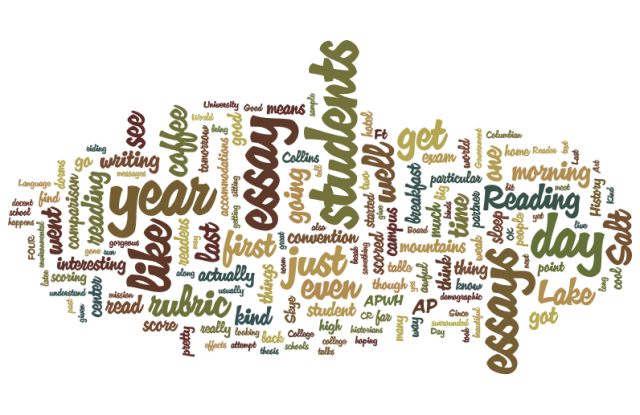Good morning from Salt Lake! It’s day 2 of the Reading, and I am sitting at the desk in my hotel room with a gorgeous view of mountains out of my window. This particular angle does not give me the snow-capped mountains, but I do get mountains nonetheless. Kind of cool to be surrounded by mountains like this!
It’s going to be a beautiful day here in Salt Lake, with a high of 77, and about 25% humidity. Back home it’s going to be 90, so this is just wonderful. (Although in all honesty, I could do with a skosh more humidity, but not the levels they’ll have at home, thank you).
The first day of the Reading went well – we started with our opening meeting with the new Chief Reader, and a fairly long, drawn out metaphor about missionaries (that we are world historians and on a mission to bring world history back into American high schools). Some amazing statistics: 208,000 students took the APWH exam this year, which means that we have about 624,000 essays to score.
I mentioned yesterday that I am on the comparison essay this year, and so far it seems to be going OK. There are a couple of tricky things about the rubric, so I’m hoping that this morning will help solidify it for me. Having only gone through 1 folder of actual live essays (that’s just 25 … my reading partner reads v e r r r r r y s l o w l y.), I can’t say with much certainty that the students are writing all the essays this year, but out of the 25 in yesterday’s folder, only 3 students left the comparison essay completely blank.
Since we are here in Salt Lake at the convention center, this year we are not the only readers in the area. In addition to AP World History, we are joined by AP Chinese Language and Culture, Japanese Language and Culture, Latin (Virgil), Art History, Studio Art and US Government & Politics. I have several colleagues from other schools here reading the AP Government exam, so I run into them randomly throughout the day (although I have yet to run into the colleague from my school reading gov’t…).
Our accommodations are a far cry from previous years as well. Since I started reading exams for APWH, we’ve been at Colorado State University in Ft. Collins, CO. Ft. Collins is gorgeous, and it’s a cute town too. The CSU campus is pretty (and since I went to New York University, the campus is HUGE and I am SO NOT USED to that), and we were staying in campus dorms. As you can imagine, our accommodations were…well, they were dorms. You know what that means.
We moved here to Salt Lake because we are too big for CSU’s campus. (We’ve got 1030 readers.) How have our accommodations changed? Well, I am in a hotel, for starters. It’s a FOUR STAR hotel. My room is about the size of my apartment, and I am NOT exaggerating. The bed is king sized (as opposed to the smaller than twins you get in college dorms), and when I came back last night, there were chocolates on my pillow. Chocolates. On. My. Pillow.
A girl could get used to this!!!
The only problem so far – the coffee has been so weak that it might as well be water…
I am on a mission to find a decent cup today. Or three.
In terms of Salt Lake itself, I am enjoying being here because it’s a city. As my friends know, I am a city girl through and through. I like concrete and tall buildings. I like being surrounded by people (but not crowded by them…it’s an interesting contrast). I am not a fan of great big, wide open spaces. It’s not an agoraphobic kind of thing, it’s just a discomfort kind of thing. I like knowing that around the corner or down the block is a bodega or an ATM or a Rite Aid (even if it does close at 7pm) or a reliably good book store (used, for rummaging…found one on Sunday. Am going to pick an evening to explore more fully). Ft. Collins was pretty, but it was too spread out. It was too … not city-ish. (I went to Scotland one year, the Isle of Skye. Gorgeous. Beautiful. So glad I went. Spent much of my time wondering how the people (what, there were only like 50 of them, right?) living on Skye didn’t go mad from the open spaces and lack of other humans. There are more sheep on Skye than people!) So all in all, I will say that the switch to Salt Lake has been a positive one.


